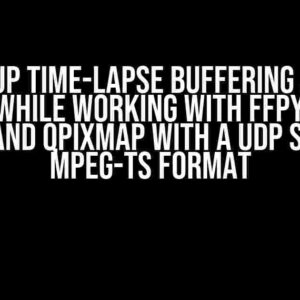As a Golang developer, you’re no stranger to the concept of method overriding and method resolution. But have you ever stopped to think about the intricacies of method resolution order in Golang? If not, buckle up, because today we’re about to dive into the fascinating world of method resolution order and explore how it can make or break your Go programs.
What is Method Resolution Order?
Method resolution order refers to the order in which Go resolves method calls on an interface or struct. In other words, when you call a method on an interface or struct, Go needs to determine which implementation to use. This might seem straightforward, but trust us, it’s not as simple as it sounds.
The Basics of Method Resolution Order
To understand method resolution order, let’s start with a simple example. Suppose we have an interface `Shape` with a method `Area()`:
type Shape interface {
Area() float64
}
type Circle struct {
radius float64
}
func (c *Circle) Area() float64 {
return math.Pi * c.radius * c.radius
}In this example, the `Circle` struct implements the `Shape` interface and provides its own implementation of the `Area()` method. Now, let’s create a `main()` function to demonstrate method resolution order:
func main() {
c := Circle{radius: 5}
s := Shape(c)
fmt.Println(s.Area()) // Output: 78.53981633974483
}In this example, when we call `s.Area()`, Go resolves the method call by looking for an implementation of `Area()` in the `Circle` struct. This is because the `Circle` struct is the underlying type of the `Shape` interface.
Method Resolution Order in Action
Now that we’ve covered the basics, let’s explore some more complex scenarios to illustrate method resolution order in action.
Scenario 1: Multiple Implementations
What happens when multiple structs implement the same interface and provide their own implementations of a method?
type Shape interface {
Area() float64
}
type Circle struct {
radius float64
}
func (c *Circle) Area() float64 {
return math.Pi * c.radius * c.radius
}
type Rectangle struct {
width float64
height float64
}
func (r *Rectangle) Area() float64 {
return r.width * r.height
}In this scenario, both the `Circle` and `Rectangle` structs implement the `Shape` interface and provide their own implementations of the `Area()` method. When we create an instance of `Shape` with an underlying type of `Circle` or `Rectangle`, Go resolves the method call based on the underlying type:
func main() {
c := Circle{radius: 5}
s := Shape(c)
fmt.Println(s.Area()) // Output: 78.53981633974483
r := Rectangle{width: 4, height: 5}
s = Shape(r)
fmt.Println(s.Area()) // Output: 20
}As expected, Go resolves the method call based on the underlying type of the `Shape` interface.
Scenario 2: Embedding Interfaces
What happens when an interface embeds another interface, and multiple structs implement the embedded interface?
type Shape interface {
Area() float64
}
type Colored interface {
Color() string
}
type ColoredShape interface {
Shape
Colored
}
type Circle struct {
radius float64
}
func (c *Circle) Area() float64 {
return math.Pi * c.radius * c.radius
}
func (c *Circle) Color() string {
return "Red"
}In this scenario, the `ColoredShape` interface embeds both the `Shape` and `Colored` interfaces. The `Circle` struct implements both interfaces and provides its own implementations of the `Area()` and `Color()` methods.
func main() {
c := Circle{radius: 5}
cs := ColoredShape(c)
fmt.Println(cs.Area()) // Output: 78.53981633974483
fmt.Println(cs.Color()) // Output: Red
}As expected, Go resolves the method calls based on the interfaces implemented by the `Circle` struct.
Now that we’ve explored some scenarios, let’s talk about the type hierarchy and how it affects method resolution order.
| Type | Method Resolution Order |
|---|---|
| Interface | Embedded interfaces, then self |
| Struct | Embedded structs, then self |
The type hierarchy plays a crucial role in method resolution order. When resolving a method call, Go first looks for an implementation in the interface or struct itself. If it doesn’t find one, it looks in the embedded interfaces or structs.
Type Embedding
Type embedding is a powerful feature in Go that allows us to embed interfaces or structs within another interface or struct. But how does it affect method resolution order?
type Shape interface {
Area() float64
}
type Colored interface {
Color() string
}
type Circle struct {
Shape
Colored
radius float64
}
func (c *Circle) Area() float64 {
return math.Pi * c.radius * c.radius
}
func (c *Circle) Color() string {
return "Red"
}In this example, the `Circle` struct embeds both the `Shape` and `Colored` interfaces. When we call a method on the `Circle` struct, Go resolves the method call based on the type hierarchy:
func main() {
c := Circle{radius: 5}
fmt.Println(c.Area()) // Output: 78.53981633974483
fmt.Println(c.Color()) // Output: Red
}As expected, Go resolves the method calls based on the embedded interfaces and the `Circle` struct itself.
Now that we’ve explored the intricacies of method resolution order, let’s discuss some best practices to keep in mind:
- Keep your interfaces small and focused. Avoid embedding multiple interfaces within another interface.
- Use type embedding judiciously. Embedding interfaces or structs can make your code more concise, but it can also lead to method resolution order chaos.
- Avoid method name collisions. When multiple structs implement the same interface, ensure that method names don’t collide.
- Document your interfaces and structs. Clearly document the methods and behavior of your interfaces and structs to avoid confusion.
Method resolution order is a critical concept in Golang that can make or break your programs. By understanding the intricacies of method resolution order, you can write more robust, maintainable, and efficient code. Remember to keep your interfaces small and focused, use type embedding judiciously, avoid method name collisions, and document your interfaces and structs. With these best practices in mind, you’ll be well on your way to becoming a Golang master.
So, the next time you encounter a method resolution order conundrum, remember to take a step back, breathe, and recall the principles outlined in this article. With practice and patience, you’ll become a pro at navigating the complex world of method resolution order in Golang.
Happy coding!
Frequently Asked Question
Get ready to unravel the mysteries of Method Resolution Order in Golang!
What is Method Resolution Order in Golang?
Method Resolution Order (MRO) in Golang refers to the order in which methods are searched for in a struct’s embedded fields and interfaces. It’s a crucial concept in Golang’s type system, ensuring that methods are called correctly when structs are embedded or interfaces are implemented.
How does Golang determine the Method Resolution Order?
Golang determines the MRO by traversing the struct’s embedded fields and interfaces in a specific order. It starts with the current type, then moves to its embedded fields, and finally checks the interfaces implemented by the type. The order is determined by the declaration order of the fields and interfaces, from top to bottom, left to right.
What happens when there are multiple methods with the same name?
When there are multiple methods with the same name, Golang will choose the one that is closest to the current type in the MRO. If multiple methods with the same name are found at the same level, the one declared most recently will be chosen. This ensures that the most specific implementation is used, reducing ambiguity and conflicts.
Can I change the Method Resolution Order in Golang?
No, the Method Resolution Order is determined by the Golang language specification and cannot be changed. The order is determined at compile-time, based on the struct’s declaration, and is not modifiable at runtime.
Why is understanding Method Resolution Order important in Golang?
Understanding MRO is crucial in Golang because it helps developers predict and manage method calls, avoid conflicts, and ensure correct behavior in complex type hierarchies. It’s essential for writing robust, maintainable, and efficient Go code, especially when working with embedded structs and interfaces.


